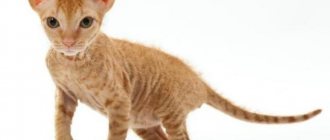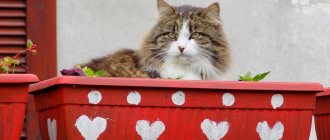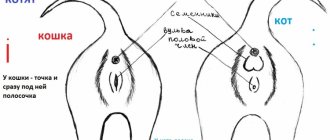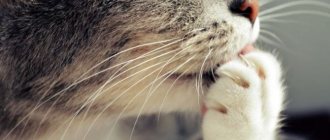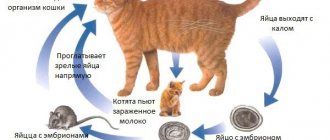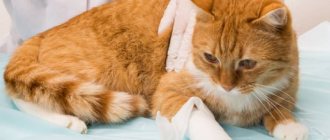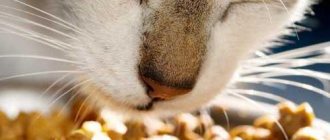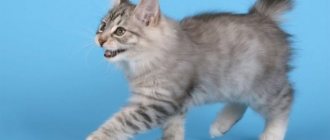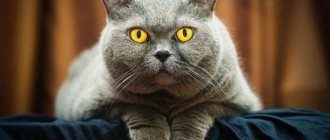The thick, beautiful fur coat of a domestic cat, no matter how long it is or what breed it belongs to, is a natural protection for both the thin cat’s skin and the cat’s entire body from uncomfortable environmental temperatures, pathogens, excessive humidity, and all kinds of traumatic factors.
And a fur coat shining with health is the pride of the owners. It is important that at any time of the year the animal’s coat is healthy, shiny and clean.
Cat fur is a mirror of health
Of course, most cats are very clean and are able to clean themselves. And thanks to their flexible spine, they do this great. But still, the kitty cannot do without the help of the owner.
What to do to make your cat have beautiful fur: 5 tips
Cats are clean and handsome. In nature, whiskers take care of their fur on their own, but at home you can help them look even more luxurious. We will give 5 tips on how to improve your cat's coat.
The appearance of a pet is a mirror of its health. If a cat has bad hair, the first thing to do is take the animal to the veterinarian. Dull hairs, too much and sudden shedding, and the appearance of bald spots can be symptoms of serious illnesses. And here you can’t get by with special food, vitamins or bathing.
1. Adjust your cat's diet
A balanced diet will 99% help improve your cat's coat. If you feed your animal natural food, be sure to discuss the menu with your veterinarian. He will tell you which products to add and which to exclude.
If you feed your cat with industrial food, choose a good cat food to improve its coat. This can be a complete GO cat food. It is suitable for both adult animals with different activity levels and kittens.
2. Sow grass for the cat
Set aside a place on the windowsill for a small tray of wheat germ, oats, or a special collection of “Grass for Cats” (sold in pet stores and seed stores). Such an addition to the diet will not immediately improve the cat’s fur, but the “apartment” resident will definitely like it and will affect her appearance over time.
Greens will help remove hairballs from the stomach easily. This will help avoid serious health problems (sometimes so much hair and undercoat accumulates in the stomach that surgery is required). Sprouted grass is especially relevant in the cat’s menu during periods of shedding.
3. Brush your cat regularly
What can you do to make your cat have beautiful fur? Brush it regularly. Buy a good comb/brush that matches the length of the hair and the size of the animal. Train yourself and your pet to brush at least every other day. A furminator is also a special “comb” that effectively removes dead hairs from the undercoat. It is enough to use it once a week, during the molting period - 2 times.
The cat has bad fur. What to do? Perhaps this is a seasonal molt and you just need to get through it.
Brushing does more than just improve your cat's coat. This is a simple and enjoyable procedure for most furry pets:
- prevents the formation of tangles. Mats often appear in long-haired breeds with abundant undercoat; removing them is not always a pleasant procedure for the animal. Therefore, it is better to prevent tangles than to cut them later;
- reduces the amount of scattered hair on furniture, floors, clothes, as dead hairs are removed with a comb;
- prevents the stomach from becoming clogged with hairballs. Yes, it is impossible to remove all the dead hair from a cat, but it is possible to reduce what it eats with each wash.
4. Keep your skin healthy
Another recommendation on what to do to ensure your cat has beautiful fur is to monitor the health of its skin. Regularly inspect your body for ringworms, sores, lesions, ticks, lice and fleas. Yes, yes, even those cats who never leave the threshold of the apartment periodically develop skin parasites. Lice and fleas can easily be brought in on your clothes, shoes, or with any items from the street. Moreover, they are completely independent and will cross the threshold of the apartment, and then end up in the cat’s fur.
Be sure to give your cat anthelmintic medications once every 3 months - for prevention. Sometimes, in order for a cat to have beautiful fur, it is enough to get rid of parasites.
5. Stop bathing your cat often
If a cat has bad fur, it is not enough to know what to do. You need to determine what not to do. For example, do not bathe your cat more than once a year. Why?
- firstly, it is stress, both for the animal and for you. And stress is bad for everyone;
- secondly, you wash away the natural protective layer from the fur and skin.
Fluffy takes care of his hygiene on his own. You cannot do without bath procedures in several cases:
- doctor's recommendation (skin diseases, presence of parasites, etc.);
- very dirty cat. For example, if you just adopted a pet from the street.
If your pet has dirty its paws or other parts of its body, you should not bathe it all. It is enough to wash only the dirty part of the body.
There are medicated shampoos and special care products that can improve a cat's coat. Use them only after consulting a veterinarian or groomer.
What do you do to make your cat have beautiful fur? What cat food do you choose to improve their fur? Share your tips in the comments!
What building?
Hair consists of 2 parts: the hair follicle, located under the skin, and the shaft. In addition, each hair consists of 3 layers:
- Cuticle. Layered on top of each other, tightly connected keratin scales that form the top layer of hair. Dry and dull hair on a cat is a consequence of damage and separation of scales.
- Cortex. It is a cortical layer consisting of dead cells. In addition, the cortex contains a pigment that determines the main color of the animal.
- Brain matter. Provides nutrition to the cuticle and cortex.
Beautiful fur in cats: how to achieve
A fluffy cat, shining with health, is the pride of any owner. But what can you do to ensure that your fur is always attractive? We'll talk about this in our article.
3 main factors for a beautiful cat appearance:
- proper and regular care,
- balanced diet,
- suitable microclimate in the house.
In order for your pet to have a healthy coat and well-groomed appearance, you need to follow all the rules.
Content
Symptoms of the disease
Food allergies often appear within a few minutes of consuming the product. There is a rash, itching, redness, swelling of the skin of the hands, face and neck. Many people complain of a sore throat, heartburn, and bloating. Children and adolescents are at high risk of anaphylactic shock, acute urticaria, eczema, and asthma.
In adults, the following symptoms most often develop:
- chronic urticaria;
- atopic dermatitis;
- rhinitis and conjunctivitis;
- gastritis;
- migraine;
- dermatitis.
According to statistics, skin manifestations are observed much more often. The rash is usually erythematous in nature. Elements of the rash can be located on any part of the skin. Dermatological manifestations persist from several hours to several days, then disappear on their own provided there is no further contact with the allergen.
When it enters the body again, the allergy develops again. There is a possibility that each episode will be more severe and intense.
Food allergies cause gastrointestinal problems within the first hours. The following symptoms are usually noted:
- stool disorders;
- abdominal pain, bloating;
- vomiting
With high allergic readiness, these symptoms develop already at the time of consumption of the allergen. It happens that dyspepsia is accompanied by immediate swelling of the mucous membranes of the mouth, lips, and tongue; nasal congestion.
Some varieties of fish, strawberries, and peanuts cause the most severe systemic reactions - angioedema, anaphylactic shock.
People suffering from bronchial asthma or food allergies often experience an attack that develops as a cross-allergy. Headaches, fatigue, and weakness appear after eating potentially dangerous foods.
Proper nutrition
The appearance and well-being of a cat largely depend on nutrition. If the diet is unbalanced, then this usually affects the quality of the coat: it becomes dry, loses its shine and elasticity, and hair begins to split and fall out. To avoid this, choose a complete ready-made food for your cat - it already contains all the necessary nutrients, vitamins, and minerals. Long-haired cats may also need a product to help remove hair from the gastrointestinal tract. A veterinarian will help you decide on the choice of diet and supplements, taking into account the cat’s breed, age, activity, and health status.
Remember that the animal’s diet should not include food from your table. If you want to cook for your pet yourself, study in advance the daily intake of calories, fats, proteins, carbohydrates, vitamins, micro- and macroelements that the cat should receive, and pay attention to prohibited foods. Among them are fish, poultry and meat bones, sweets, herbs, avocados, smoked meats, etc. For smooth coat and healthy skin, it is important to choose foods rich in B vitamins (beef liver, meat, dairy products, etc.), vitamin A ( egg yolks, sea fish liver, etc.), omega-3 and omega-6 fatty acids (salmon, eggs, etc.).
Difference from hair
All mammals, including humans, have hair on their bodies, the number and structure of which depends on their functional purpose.
The hair of animals has the ability to provide thermal insulation, which distinguishes it from humans.
When thick, thick hair grows all over the body, it is called fur. In cats, hair is called fur. Any type of hair, regardless of structure and other characteristics, grows from a follicle. In different areas, the hairs differ in structure and density. The main difference between human hair and animal hair is that the latter’s core of the hair follicle has the peculiarity of providing reliable thermal insulation. In humans, the composition of hair has the same structure, but in animals, hair consists of guard and integumentary hairs.
Indoor microclimate
Is there a lot of yellow light bulbs in the house, is the air dry? In this case, the cat's fur may become dry and lifeless. For the health and beauty of your pet, pay attention to the microclimate in the house. Various ways can help improve it:
- frequent wet cleaning without the use of chemicals;
- regular ventilation of rooms;
- reducing heating intensity. If this is not possible, make sure that the cat does not sleep on the radiators. Equip her with a cozy house or bed;
- using a humidifier.
If you think you're doing everything right, but your cat's appearance still isn't up to par, visit your veterinarian. Coat problems can be symptoms of various diseases. Also, do not forget about routine medical examination, vaccination, and deworming of your pet. All this can help your cat be healthy for many years and delight you with its beauty and playfulness.
Sources:
https://allexpert.com.ua/chto-delat-chtoby-u-koshki-byla-krasivaya/ https://www.ikirov.ru/news/32833-8-sposobov-privesti-sherst-koshki-v- poryadok https://www.vetmag.ru/advice/koshki-uhod-za-sherstyu/kak-dobitsya-krasivoj-shersti-u-koshek/
Causes of food allergies
There are several mechanisms for the development of allergies. But a significant proportion of cases are associated with type 1 hypersensitivity. It is explained by the release of immunoglobulin IgE and the activation of basophils. This reaction occurs in response to the entry into the digestive system of protein compounds recognized by immune cells.
Some predisposing factors are unique to children, others are also found in adults. Among the most common reasons are the following:
- Features of allergens in food. The reaction is most often provoked by antigens with high immunogenicity. They easily overcome the aggressive environment of the stomach. They are found in large quantities in whole milk, fish, eggs, cereals, strawberries, citrus fruits, and nuts.
- Hereditary predisposition. Food allergies are associated with hereditary characteristics of the body. They manifest themselves by increased reactivity, disruptions in the functioning of the immune system, as well as other mechanisms.
- Age-related features of the development of the digestive system. Children have high permeability of the stomach walls, and the acidity of gastric juice is lower than in adults. The composition of the microflora is also different. All this creates favorable conditions for the allergen to come into contact with immune cells.
The condition may be associated with the amount of food eaten and the characteristics of culinary processing. There are cases of so-called cross-allergy to pollen and household dust: some food products with similar compounds in their composition trigger an allergic reaction.
According to many researchers, the formation of allergies is facilitated by dietary violations during pregnancy, as well as early transfer of the child to artificial feeding. Gastrointestinal diseases, especially diseases of the liver, gallbladder, and biliary tract, also trigger and contribute to the exacerbation of allergies.
Bathing
By licking itself, the cat cleans its fur of debris and dust, but dead skin particles remain on it - they will have to be washed off, regardless of the animal’s dissatisfaction.
Before bathing, we recommend trimming your cat’s nails and combing out tangles. Remember that your cat should only be washed with special shampoo from a pet store or veterinary pharmacy, as human shampoos can cause itching in the animal. It is better to bathe a cat together: one person should carefully hold the animal, and the second should soap it.
It is important to ensure that water does not get into your ears or nose. The muzzle cannot be washed with water - it is wiped with a damp sponge. You need to rinse the shampoo thoroughly until the water runs clear. It is especially important to monitor this if the cat belongs to a long-haired breed. But it is not necessary to dry your pet dry; just blot it with a towel to moderate humidity. However, if the cat is not afraid of a hair dryer, then you can use it.
